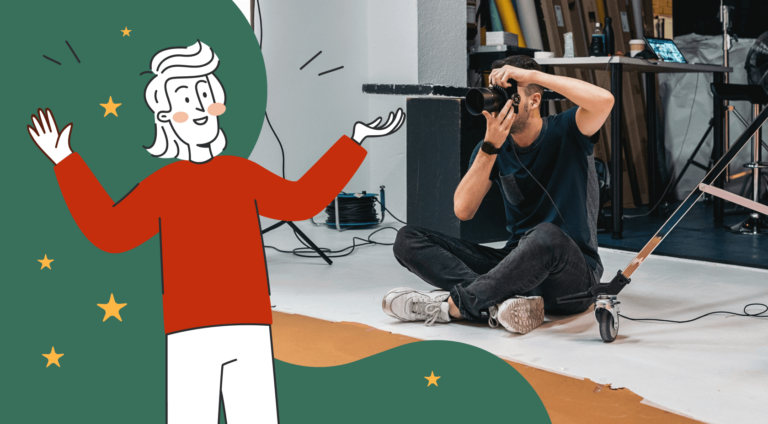HoneyBook is a project management software dedicated to freelancers and small businesses of a variety of industries. It comes with a machine-like range of features, from one of the best document creators we’ve seen to well-developed projects, to-dos, invoices, payments, and even email marketing.
This software must have by now curled up on our blog’s couch, got the biggest coffee mug they could find, and turned on the TV, because we’ve talked about it so many times already.
In the past, we’ve compared it to many similar solutions, like Dubsado or Bloom, and most of the time, HoneyBook came out of these battles completely intact, leaving their competitors in the dust.
But today, we’re ditching the idea of comparing HoneyBook to other tools or even looking at this software as a whole. Instead, we’ll be a bit nitpicky and lean over one specific feature — the HoneyBook client portal.
Is it HoneyBook’s strongest suit?
Discussing The Ideal Client Portal Solution
But first, let’s soak in the world of unicorns and fluffy clouds made of ice cream to discuss the ideal client portal, and keep that mystical creature with us in mind for the rest of the article.
Generally speaking, an ideal client portal is a client-accessible space that allows them to view & share files, complete payments, check on their projects or orders, sign contracts, schedule meetings, get in touch with the team they’re working with, and even more, preferably all under an intuitive UI.
The best client portals also come with vast amounts of white-labeling options, to make sure the branding of the business using the client portal stays consistent for the end client, eliminating the slightest chance for confusion.
Client portals are usually available in the form of a SaaS (Software as a Service) solution, i.e., just like any other website — online.
And that’s how many project and business management software offer a client portal as one of their features, but there are also completely stand-alone client portal software platforms, as well as hybrid solutions.
In HoneyBook, a client portal is one of the features we get as part of this project management software as a whole.
How Does HoneyBook Client Portal Work?
HoneyBook’s client portal is a shared, under a password-protected (or not) access, project space.
Meaning, you can add your clients to each project you manage in HoneyBook, for them to view its essential details, access shared files & invoices, make payments, and message you.
You also get a private space within each project to create your notes, to-dos, and automations in peace.
And while we like the idea of keeping things coherent, the way HoneyBook executed their client portal feature makes it pretty limiting. But more on that later.
How To Integrate It?
To integrate HoneyBook client portal, all you have to do is copy the link to it and share it on your website. Either under a button or directly in the website’s menu, whichever rocks your boat.
But to make sure your client portal fits with your website and your branding, it’s best to connect a custom domain to HoneyBook first. That way, your clients won’t be confused when going from your website to your client portal.
What About Customization?
This brings us to customization.
How far can you go to make HoneyBook’s client portal feel like your own?
Well, we have three main ways to customize our client portal in HoneyBook: by changing the colors and the aesthetics of our workspace & documents, by updating the background image of our project, and by customizing the login page for our clients.
A bonus option we’ve already mentioned is to connect your own domain to your HoneyBook account, so that your client portal and any other external links will be showing up without HoneyBook as the intermediary in the URL.
In this section however, we’ll focus solely on the background image for each project and on customizing the login page, since these are the most effective for the looks of your HoneyBook client portal.
To change the background image of your project, you simply have to go to Projects, select the specific project you want to customize, and find the image icon in the bottom right corner of the background image space. Once you click on it, you have the option to upload your own image or choose one from HoneyBook’s library, which includes a few stock options.
But the actual client portal customization options, aka the login page settings, are located in the Company settings, under the Domain & Client Portal section.
And here, we can basically change the background color of our client portal login page and decide whether we’d like to add our logo, either in full size or a square version.

And that’s pretty much all the customization we get in HoneyBook’s client portal, which, if you ask us, is the standard, most software tends to go for. Good enough, but definitely not the best.
The Tabs: Covering Essentials
Leaving the aesthetics aside, let’s now focus on the actual elements HoneyBook’s client portal comes with.
In fact, it’s made up of 4 tabs:
The activity tab: shows the activity within the project, such as booked sessions or issued invoices. But most importantly, the activity tab is what you’ll be using to communicate with your clients and vice versa, as well as to check on the past conversations. Each and every email message exchanged throughout the project will be held in the activity tab.
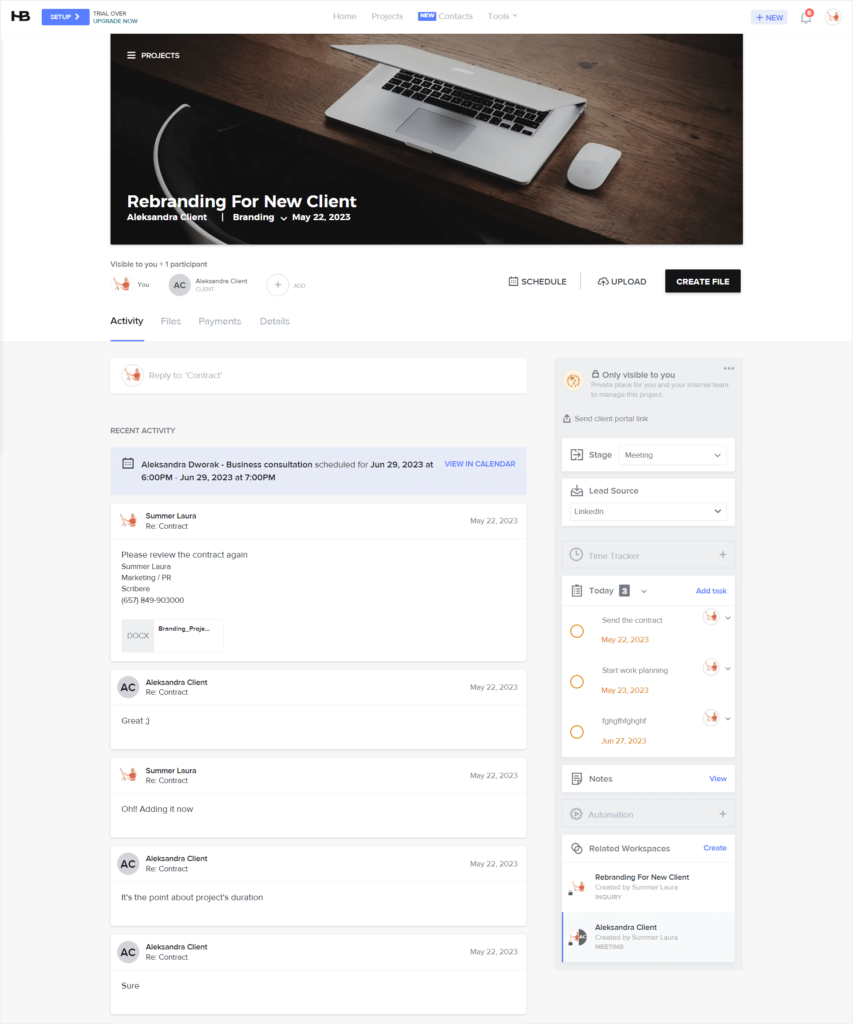
The files tab: collects any files, smart files, or images shared within the project for us and our clients to easily download any needed document or resource.
The payments tab: shows any upcoming payments and makes it easy to complete them.
The project details tab: gives your clients an easy overview of the most important details about their project. The tab, by default, shows the project’s name and type, your availability to scheduling sessions on project’s date, project’s date and location, and your description of the project. But you can customize the fields that show up in the project’s details to your liking. Underneath, you’ll find private details, which are simply the notes you’ve been making within the project, visible only to you.
On the top panel of each shared project, your clients also get to share any files or schedule a meeting or a session with you.
We also want to bring up the private space you get within each project yet again, going through the exact options we get.
First things first, we get a direct link to our client portal, which we can either copy or send to a selected client via email, along with a HoneyBook-provided template for that occasion.
Next, we get to flip a few switches and change the project’s stage, update our lead’s source, start the time tracker, or create a to-do item.
Lastly, this is also the place to view and add private notes concerning the project, and work on our automations.
The Issues: Cautiousness & Limitations
Now that we know the way HoneyBook’s client portal operates and what it’s made of, let’s dig into its imperfections.
Overall, HoneyBook’s client portal is “perfectly imperfect”. Meaning, considering the fact that this software platform is pretty dang extensive and most of the features perform great, it gets the pass to leave its client portal unpolished.
It definitely serves its basic purpose of sharing files, checking on the project’s details, or completing payments.
But should you dig deeper or require something a bit more sophisticated, you may end up feeling disappointed by some of the more nuanced issues it comes with.
Starting From The Base: Projects
We’ve already mentioned that HoneyBook’s client portal focuses on projects. It means that to have a client portal available and running for your clients, you have to have an actual project added and connected with them.
That comes as no surprise since this is a project management software, so everything here revolves around projects.
And HoneyBook’s projects are great. We love the customizable pipeline for simple overview, the fact that everything of essence is at hand’s reach: the smart files, the time tracking, the tasks, and notes.

But creeping through the slightly opened door are the limitations we’ve mentioned at the beginning of this article.
The one thing you will always have to keep in the back of your mind is that your clients will see everything that happens in the Projects view, except for the private section visible only to you. And because you use that same space to manage your project, you have to make sure that the things that are visible to clients are staying appropriate.
Communication: The Caution Loop
Communication with clients is unfortunately the biggest and the most painful needle in the HoneyBook’s client portal heel.
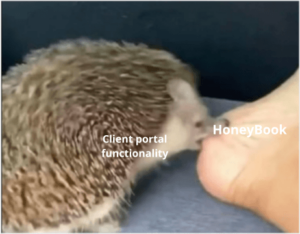
And that’s not because it’s email-based. 😉
It’s because it’s poorly executed, or at least seems rough-edged for now.
HoneyBook allows us to communicate with our clients and vice versa through the client portal, aka the project section, using something that’s both chat-like and email-like, forming something we’ll call email messages.
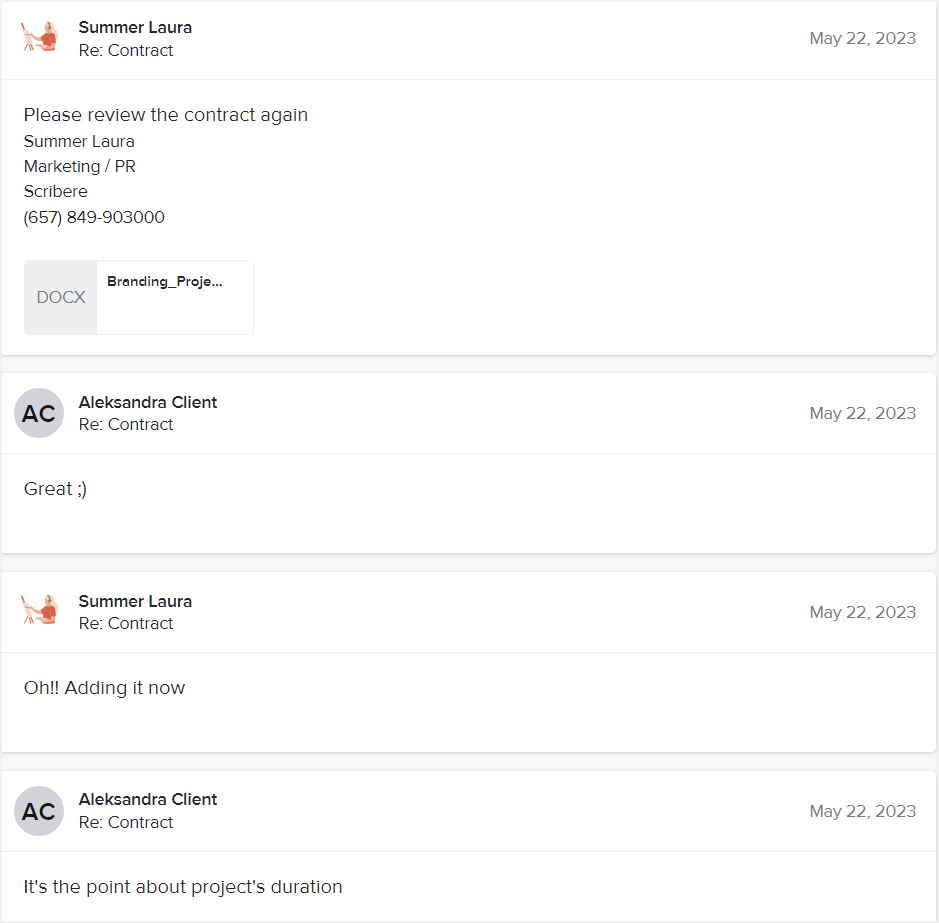
The email messages come with quite a few flaws. For one, we can’t delete any messages that have already been sent, meaning, the longer our project conversations, the longer we’ll have to scroll through the project page, because it does not fold. Not to mention the fact that once again, we’ll have to stay cautious of what we do and say in that shared space.
For two, HoneyBook allows us to respond only to the latest email thread or create a new one. But should we decide to create a new thread, the recent one will no longer be available for us or our clients to reply in, which can get messy real quick.
It’s one thing to hate back-and-forth emails, it’s a completely another issue to create a thousand threads that could have been one string of messages.
All in all, while we have to give HoneyBook a pat on the back for trying to include the client communication in the client portal, we can’t get past these imperfections.
Therefore, we must say we’d rather recommend sticking to email or moving your client communication elsewhere to keep things clear, if you’re about to be using HoneyBook’s client portal.
Payments & Geographical Limitations
We’ve mentioned that HoneyBook’s client portal makes it possible for your clients to complete payments relating to the project.
And with that we hit the biggest wall in HoneyBook. A wall not many can simply jump over.
HoneyBook decided to walk past PayPal, Stripe, or even Square, and introduce their own payment solution instead. This solution, however, is only available for the chosen ones operating from either the US or Canada.
So, if your business is not operating through either of those two countries, you’re going to have to stay on the hunt for an alternative client portal.
Luckily, the geographical limits do not apply to your clients. Those that do operate their business from the US or Canada can serve clients from all around the globe.
HoneyBook’s Client Portal Costs
Having reviewed HoneyBook’s client portal feature front and back, let’s now take a look at the last crucial factor — money.
Some software solutions offering a client portal functionality take pride in gatekeeping this feature in the highest-pricing plan. Fortunately, HoneyBook is not like the other software.
HoneyBook offers the client portal feature right from its Starter plan, which you can get for $19 per month when paying monthly, or $16 per month, when paying annually.
But, let’s not forget that HoneyBook is the queen of discounts. Perpetual discounts, even.
At the time of writing this article, we have the option to sign up to HoneyBook and pay just $1 for 2 months of using it, on any plan selected on monthly billing, as well as the option to purchase any of the plans for 50% off when choosing annual billing.
If you want to dive into HoneyBook’s pricing in depth and figure out the exact prices and differences between the three HoneyBook subscription plans, we encourage you to read our HoneyBook pricing analysis where we go all out on this topic.
HoneyBook Client Portal Alternative: Zendo
If you’ve read any of our previous articles, you may be wondering if we’re okay. How come we’d write such a short article?
As much as we appreciate the cohesiveness of HoneyBook’s client portal thanks to merging project management directly with that function, ultimately it’s what’s making this feature limited.
And if project management is not entirely your thing, and you dream of a client portal that combines efficient client communication, submitting and managing requests, purchasing services, payments, and basic features, like file sharing, it may be Zendo that you’re looking for.

Just like HoneyBook, Zendo is not just a client portal software. But instead of focusing on project management, Zendo went in the direction of service selling, easing the process of productization, creating a subscription-based offer, and untangling the intricacies of custom services.
All while giving your clients the space to check up on their latest orders and requests, chat with your team, download and share files, make new orders and requests, and more.
And the best part is that Zendo comes with a free forever plan, obstructing testing it from any limitations, but also allowing you to use its most essential features, including the client portal, completely for free. 🎉
But you may be wondering, in what way is Zendo’s client portal better than that of HoneyBook?
Well, we have a few reasons in mind. 😉
Zendo’s Client Portal: The Benefits
Besides a free forever plan, which makes Zendo a very alluring option, this software comes with quite some benefits thanks to its unconventional take on client portals.
Zendo is a modern solution, having entered the market just nearing the end of 2021, which is very much visible in its modern UI, making it extremely intuitive.
But, the novelty is also visible in its approach.
Real-Time Chat & A Transparent Client Portal
Hands down, the best part about Zendo’s client portal is how easy the client communication gets. Thanks to introducing a fully functional real-time chat instead of sticking to emails, you get to answer your clients questions and requests in a matter of seconds.
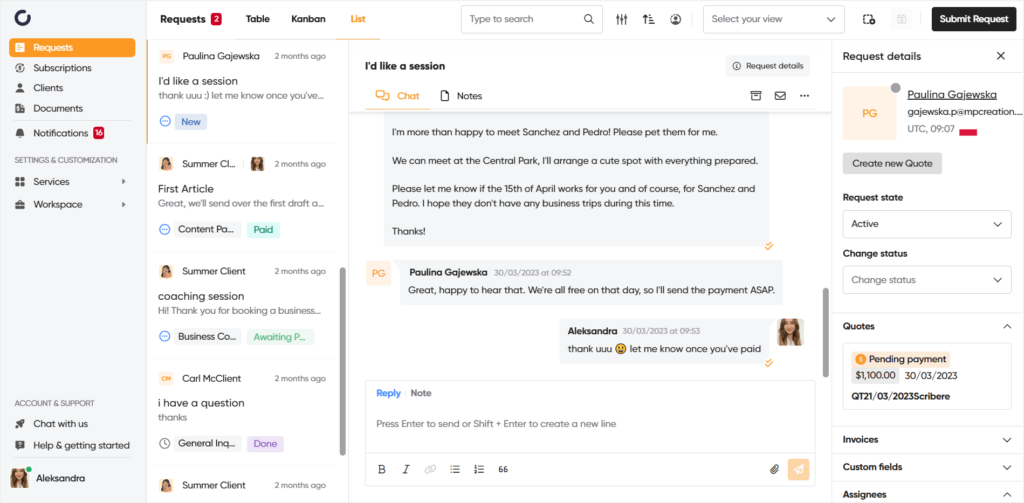
But the chat is so much more than messaging your clients, it’s also the one place you’ll be using to share files or deliver your work, send out quotes when needed, talk privately with your team, or change the order’s or project’s status.
In turn, your clients get a transparent client portal with personal dashboards, the possibility to easily complete payments, subscribe to your services and maintain their subscription automatically, submit requests, orders, and, most importantly, always feel in touch with you & your team, all on top of the real-time chat.
Productization & Subscriptions
Even the best and most functional chat for client communication won’t save you if you don’t have the right selling processes set up.
No matter what consists of your offer, custom, productized, mixed, or even subscription-based services, Zendo gives you the right tools to set your services up and sell them effortlessly.
With different types of services, a customizable Service Catalog with checkout included, order forms, add-ons, discounts, and descriptions, you’ll be on your way to create an offer of your dreams.
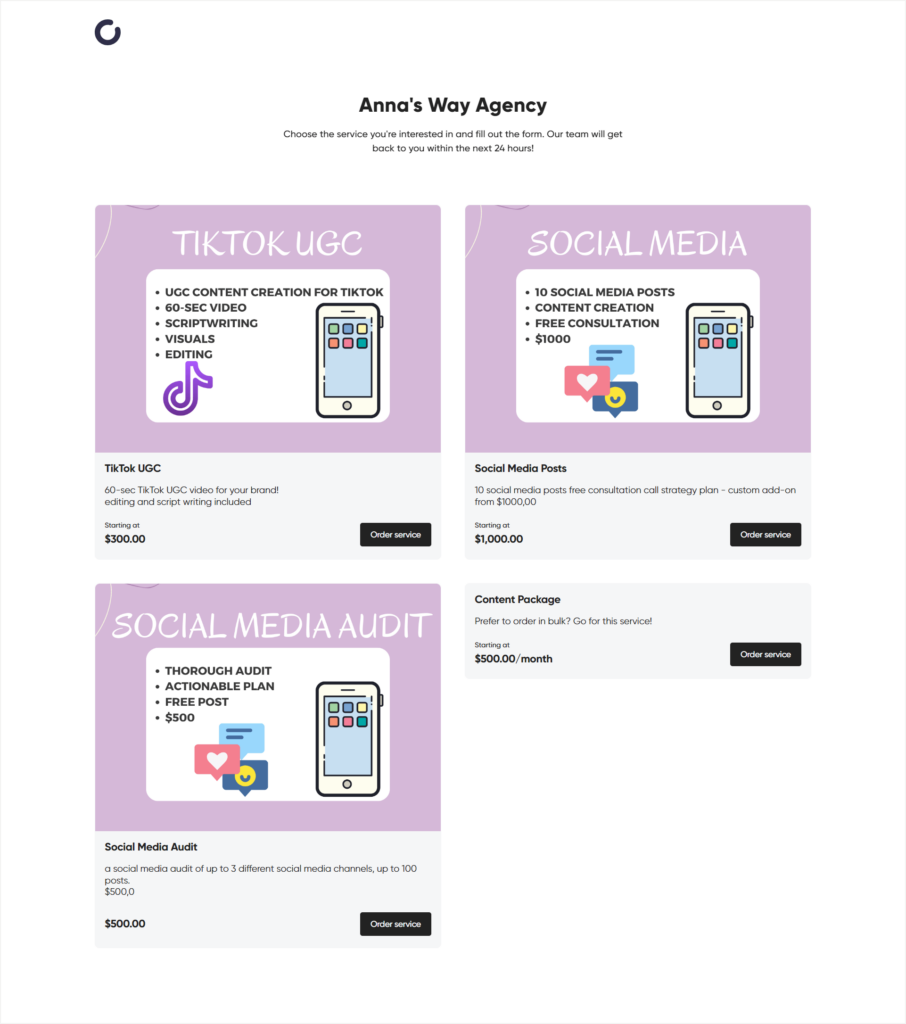
And if you already have that offer set up and running, you can easily recreate it in Zendo to combine the perfect customer experience with next-level sales, or simply add a proper checkout to what you already have.
Just like you would collect all three deathly hallows in the wizarding world, you can become the Master of Sales, while your clients stay satisfied under your reign, ordering new services, submitting requests, talking with your team, and managing their orders easily, self-serving where they can.
HoneyBook Client Portal: The Dream Of The Silent Project-To-Project World
Because HoneyBook sets the bar for most of its functionalities so high, we perceive it as a near-perfect solution. This leads us to think that its client portal will be yet another hit from this software.
And when it turns out to not be a near-perfect option, well, first we go into a shock coma, and then start to think of it negatively.
But HoneyBook’s client portal, when compared to solutions from similar software, such as Dubsado, Tave, or 17Hats, is much better. It’s much more modern, it gives us a cohesive experience, connecting the client portal with projects, it tries to include client communication, and it does include payments & and the possibility to create a custom payment schedule for each of our invoices.
We’re absolutely not saying that HoneyBook’s client portal is bad, especially when compared with others. But the flaws in this one are still there.
The difficulties in communication, the required cautiousness, or even the scarce customization options, are making us much more prone to recommend Zendo’s client portal.
Of course, as long as you’re more focused on service selling, rather than project management. With this software, your clients get personal dashboards, a real-time chat for communication, a Service Catalog for making new orders, subscriptions, requests, statuses, payments, and so much more.
And if working on a project-to-project basis is your thing, and you don’t mind sticking to email-based client communication, well, then HoneyBook will definitely be a good client portal choice!

A free online training. Delivered daily to your inbox to grow your productized agency.
Frequently Asked Questions: HoneyBook Client Portal
Does HoneyBook Have A Client Portal?
HoneyBook does have a client portal feature included in their software. Since this tool is focused on project management, the client portal reflects that as well. The client portal is basically sharing the project we manage in HoneyBook with our clients, with client-accessible and private spaces division.
What Are The Pros & Cons Of A HoneyBook Client Portal?
The main pros of the HoneyBook client portal are: the fact that we can make it password-protected, the fact that it’s cohesive with the rest of the software, being directly connected with the projects we manage, and the fact that it includes payments, and scheduling meetings. In turn, the main cons are: the included client communication, which seems rough-edged for now, the geographical limitations on businesses that want to use it (you have to operate either from the US or Canada), and the fact that we have to share the same space we use to manage projects, which may require some cautiousness.
How Can You Customize HoneyBook’s Client Portal?
You can customize your HoneyBook client portal in three main ways. The first one is to customize your HoneyBook’s workspace, changing the colors and the aesthetics. The next one is to connect a custom domain to ensure consistent branding for your clients. You can also customize the login page to your client’s portal, updating the background and adding your logo in the settings of the software. Last, but not least, is changing the background image for each project you share with your clients.
How Much Does HoneyBook Client Portal Cost?
The client portal functionality is included right from HoneyBook’s Starter plan, which costs $19 per month, on monthly billing, and $16 per month, on annual billing. However, HoneyBook often offers discounts, even allowing us to purchase a subscription to this software for just $1, so make sure you keep an eye out for HoneyBook sales.
What Is The Best HoneyBook Client Portal Alternative?
If you want to shift the focus from project management to service selling & productization, dream of an effective client & team communication, and would love your clients to be more independent in the sales process, Zendo is your best HoneyBook client portal alternative. It comes with personal dashboards for your clients, a real-time chat, subscriptions, and a free forever plan covering the essential features for selling services and taking care of your clients.



